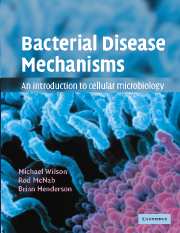Book contents
- Frontmatter
- Contents
- Preface
- Abbreviations used
- Chapter 1 An introduction to bacterial diseases
- Chapter 2 Bacterial cell biology
- Chapter 3 Molecular analysis of bacterial virulence mechanisms
- Chapter 4 Communication in infection
- Chapter 5 The mucosal surface: the front line of antibacterial defence
- Chapter 6 Immune defences against bacteria
- Chapter 7 Bacterial adhesion as a virulence mechanism
- Chapter 8 Bacterial invasion as a virulence mechanism
- Chapter 9 Bacterial exotoxins
- Chapter 10 Bacterial evasion of host defence mechanisms
- Chapter 11 Bacteria in human health and disease: the future?
- Appendix A Glossary of terms used
- Appendix B Brief descriptions of bacteria frequently mentioned
- Index
- Plate section
Chapter 6 - Immune defences against bacteria
Published online by Cambridge University Press: 05 June 2012
- Frontmatter
- Contents
- Preface
- Abbreviations used
- Chapter 1 An introduction to bacterial diseases
- Chapter 2 Bacterial cell biology
- Chapter 3 Molecular analysis of bacterial virulence mechanisms
- Chapter 4 Communication in infection
- Chapter 5 The mucosal surface: the front line of antibacterial defence
- Chapter 6 Immune defences against bacteria
- Chapter 7 Bacterial adhesion as a virulence mechanism
- Chapter 8 Bacterial invasion as a virulence mechanism
- Chapter 9 Bacterial exotoxins
- Chapter 10 Bacterial evasion of host defence mechanisms
- Chapter 11 Bacteria in human health and disease: the future?
- Appendix A Glossary of terms used
- Appendix B Brief descriptions of bacteria frequently mentioned
- Index
- Plate section
Summary
Aims
To introduce the reader to:
the concept of immunity against bacterial infections
the cell populations involved
the soluble mediators involved
the organisation of the immune system
innate immunity and recognition of pathogens
mechanisms of phagocytosis and bacterial killing: linking innate and acquired immunity
acquired immunity, generation of diversity and antigen presentation
how these systems work together to kill bacteria
Introduction
Many of our defence mechanisms against infection function at mucosal surfaces, are continually active and are generally invisible to us. These various defence systems have been described in Chapter 5 and the linkage between epithelial ‘immunity’ and what would classically be called immunity has been made. This chapter will consider the antibacterial defence mechanisms that can be thought of as being ‘post-mucosal’ and will describe the systems of cells and mediators that are normally thought of when the term ‘immunity’ is used. The reader has to understand that, for the purposes of teaching, the various systems that defend us against bacterial infection are parcelled up into distinct categories (‘innate’ versus ‘acquired’, or ‘humoral’ versus ‘cellular’). However, in reality, they work as one seamless mechanism. Unfortunately, we do not yet understand all the links that exist between these systems and the challenge is to identify the connections.
Before entering the fascinating realm of antibacterial immunity, the reader must be warned that modern immunology, which has developed largely since the 1960s, was created at a period when the world thought itself safe from bacterial infections.
- Type
- Chapter
- Information
- Bacterial Disease MechanismsAn Introduction to Cellular Microbiology, pp. 278 - 352Publisher: Cambridge University PressPrint publication year: 2002



